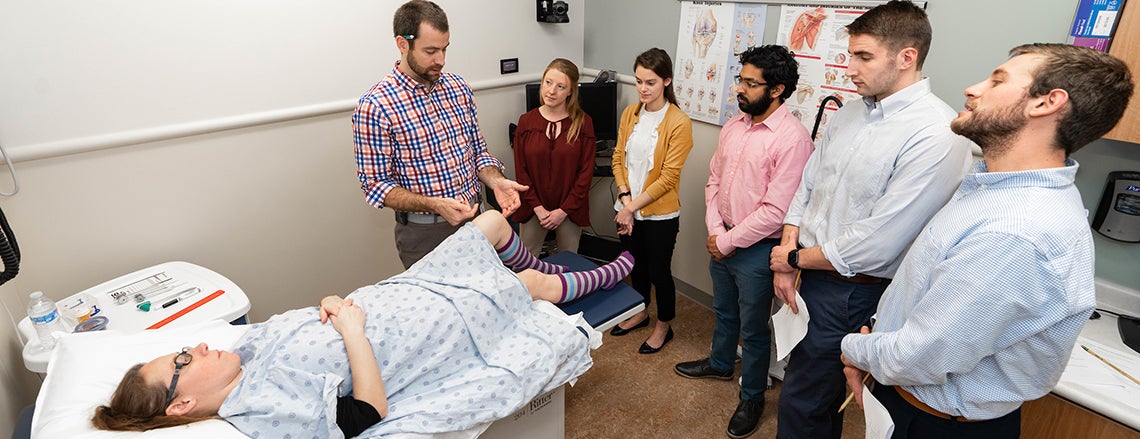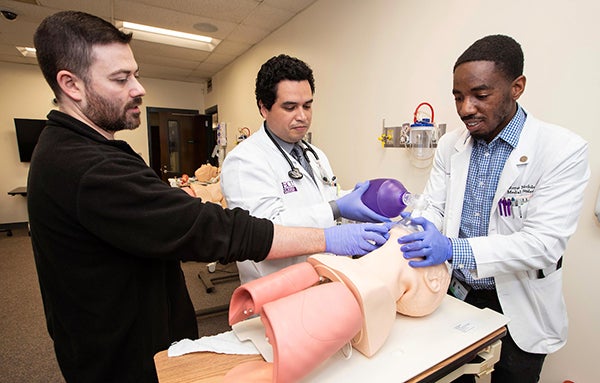IMPROVING MEDICAL EDUCATION
Important partnership of ECU, other leading medical schools gets extension
A handpicked group of the nation’s leading medical schools – of which ECU’s Brody School of Medicine is a founding member – will have extra time to partner on projects that will shape the future of medical education and health care delivery in the U.S.
In 2013, 80 percent of the nation’s medical schools applied for grant funding through the American Medical Association’s Accelerating Change in Medical Education (ACME) initiative, which aims to bridge the gap between how future physicians are trained and how health care is delivered.
Brody was one of only 11 medical schools – including New York University School of Medicine, Mayo Medical School and University of California, San Francisco – to be awarded a five-year, $1 million grant under the AMA program.
“We always think of ourselves as the ‘smaller’ school, but we have done as much great work as any of the other great institutions out there,” said Dr. Luan Lawson, Brody’s assistant dean for curriculum assessment and clinical academic affairs. “This was really an opportunity for that work to be recognized nationally by other institutions, and for other individuals to see that Brody is leading the way.”
During a visit to ECU in March, AMA officials said they “got it right” by choosing to invest in Brody.

Dr. Evan Lutz, ECU clinical assistant professor of family medicine and interim director of the sports medicine division, instructs second-year medical students. (Photo by Cliff Hollis)
“The health care system has been broken for a while in ways where we need physician leaders and nurse leaders to say, ‘the system can be fixed, and here are ways that we can fix it.’ This is what Brody has been bringing to medical education that wasn’t there before,” said Dr. Susan Skochelak, AMA’s group vice president for medical education. “It is, at a very practical level, giving people tools to close gaps that we think are important in the health care system. And the Brody School of Medicine has been at the forefront as a leader in this area.”
The innovations that grew out of Brody’s involvement in the AMA program included:
- Development of a longitudinal curriculum in health system science focusing on developing skills related to patient safety, quality improvement, systems science, population health and interprofessional team-based care.
- Creation of the nationally recognized Teachers of Quality Academy, a year-long faculty development program that has thus far trained 78 medical, nursing and allied health faculty members in new health science competencies.
- Creation of the Leaders in Innovative Care (LINC) Scholars program, which leads to graduation with distinction in health system transformation and leadership for a small group of competitively selected medical students. The inaugural cohort of five LINC scholars graduated in May.
Because of achievements such as these, the AMA and its ACME partner institutions – which now include an additional 21 schools – recently committed to spending three more years on the initiative.

Brody was one of only 11 medical schools nationwide to be awarded a five-year, $1 million grant in 2013 under the American Medical Association’s Accelerating Change in Medical Education initiative. (Photo by Rhett Butler)
“Our consortium of medical schools has been an invigorating and productive community of innovation over the past five years,” Dr. James Madara, chief executive officer of the AMA, said in a release. “Knowing that our work to transform medical education is far from finished, the AMA is excited to continue to foster this environment where individuals and institutions can learn from each other and innovate.”
Moving forward, the consortium will work to better refine its existing projects and also begin work on addressing topics such as: social determinants of health, curricular innovations to improve student well-being, improving quality of care and enhancing patient safety.
“A lot of the health of patients is dependent upon factors beyond the actual provider patient care that they receive,” Lawson said. “So this really helps our students better understand what the pieces are that contribute to the health of patients so we can to begin to focus more on health instead of sickness.”
According to the AMA, the consortium’s models are already supporting training for an estimated 19,000 medical students who will one day care for 33 million patients each year.
Being involved in the consortium not only gives Brody a national leadership role in shaping this medical training, it also better equips the school to meet its own longstanding mission of serving the residents of North Carolina’s rural and underserved areas, Lawson said.
“This is content that is now being embraced at a lot of large academic medical centers. But as we deploy physicians into these rural areas in which we serve, our students are better prepared to meet the changing needs of health care,” Lawson said. “It has enabled us to be on the leading edge of change for our students and for our patients.”

First-year medical students interact with a simulated patient during a classroom exercise at the Brody School of Medicine. (Photo by Cliff Hollis)
